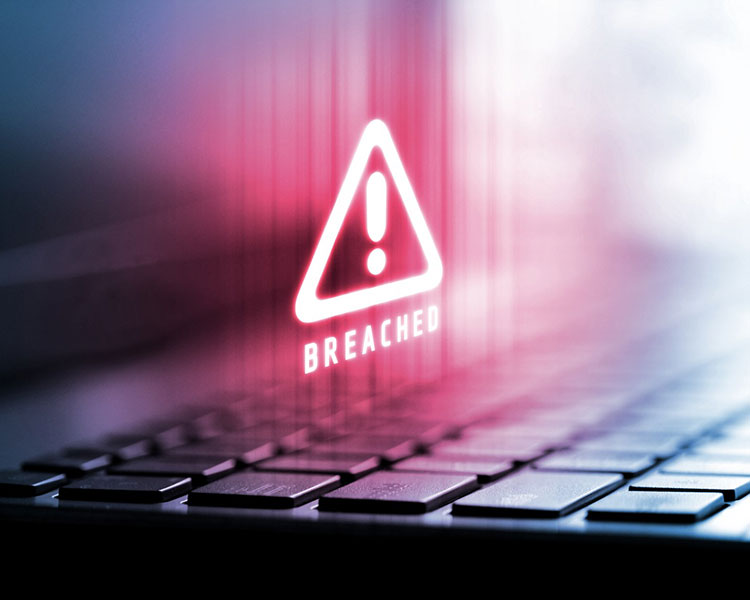Top Cybersecurity Threats for Businesses in 2023
Tips for understanding and mitigating cyber threats to strengthen your organization’s cybersecurity posture.
Cyber threats are an inevitable part of doing business. Today, every business, regardless of size or industry, is a potential target for cyberattacks. No matter how “secure” your organization may be, threat actors are constantly crafting new, complex, and strategic attacks. They will do anything to exploit vulnerabilities that could compromise sensitive data, disrupt operations, or damage your reputation.
But cybersecurity threats are also more diverse and fast-evolving than ever. From phishing and malware to ransomware and distributed denial of service (DDoS) attacks, threats are always changing. Understanding these threats is necessary for businesses to stay secure in the modern dynamic threat landscape.
This FullScope IT article cuts through the noise to explore the top cybersecurity threats businesses face in 2023. We’ll demystify the term ‘cybersecurity threat,’ introduce top threats, delve into their mechanics, and discuss their repercussions. More importantly, we’ll equip you with practical strategies to strengthen your defense, mitigate cyber threats, and enhance your business resilience.
It’s time to embrace a new, knowledge-based, and proactive approach with FullScope IT. The future of your business could depend on it.
What Are Cybersecurity Threats?
A cybersecurity threat is a potential event or action perpetrated by threat actors such as hackers, insiders, or automated malware. Typically, these attacks have one goal: to undermine your information system’s confidentiality, integrity, or availability. They are digital time bombs that can disrupt your digital resources, steal or wreck your data, impede your business operations, infringe on privacy rights, and leave a dent in your company’s reputation.
Understanding and staying ahead of cyber threats is not just good practice—it’s imperative. By staying informed about the latest threats, businesses can proactively put measures in place to protect their digital assets and minimize the risk of successful security breaches. Education is the first step to safeguarding sensitive data, ensuring operational continuity, and maintaining your company’s reputation.
Top Cybersecurity Threats in 2023
Becoming familiar with top cybersecurity threats is critical for every business. Below, we explore these threats in detail, explaining how they work and how they might affect your organization.
Malware
Short for malicious software, malware refers to any software designed to harm a system. Malware attacks include viruses, worms, Trojans, spyware, adware, and ransomware. Its primary purpose is to infiltrate, damage, or disrupt an information system, steal sensitive data, or gain unauthorized access to a network.
Ransomware
A type of malware, ransomware encrypts a victim’s files. The attacker then demands a ransom from the victim to restore access to the data upon payment.
A particularly nefarious trend in recent years is the so-called double extortion scheme. In these cases, attackers encrypt a victim’s files and exfiltrate sensitive data. Suppose the victim refuses to pay the ransom. Attackers may threaten to publish this sensitive information on the dark web or sell it to competitors. This can cause reputational harm and potential legal repercussions.
The evolution of ransomware attacks has also seen the emergence of Ransomware-as-a-Service (RaaS). This is where cybercriminals lease ransomware tools to other, less sophisticated criminals, democratizing the ability to carry out these attacks and increasing their prevalence.
DDoS Attacks
A DDoS (distributed denial of service) attack overwhelms a network, service, or server with internet traffic, rendering it unavailable to users. It’s akin to a traffic jam clogging up a street, preventing regular traffic from arriving at its desired destination. DDoS attacks are a particularly disruptive type of cyber threat, and the onslaught of traffic is usually generated by a network of compromised computers, known as a botnet.
Social Engineering
Social engineering is a strategy used by threat actors that relies heavily on human interaction to trick people into breaking routine security procedures. Examples of social engineering attacks include phishing, spoofing, baiting, quid pro quo, and tailgating. In these attacks, attackers tend to pose as trusted individuals or authority figures and rely on people’s willingness to be helpful to gain access to sensitive data.
Phishing
Phishing is the most common social engineering technique cybercriminals use to scam individuals into revealing sensitive information such as passwords, credit card numbers, or Social Security numbers. This is usually achieved through phishing emails or text messages that appear to be from a trustworthy source.
Phishing attacks can be broad or targeted, and there are several types that organizations should be aware of:
- General phishing: These attacks are typically widespread, sent to many recipients, and not personalized. They rely on the law of averages—a few people are bound to respond out of thousands of emails sent.
- Spear phishing: Unlike general phishing, spear phishing attacks are personalized and aimed at specific individuals or companies. Cybercriminals gather personal information about their targets to increase their likelihood of success.
- Whaling: These phishing attacks are directed specifically at senior executives or other high-profile targets within a business, such as the CEO or CFO. The goal is often to trick the executive into revealing personal or corporate confidential information.
Insider Threats
Insider threats are security threats that originate from within the organization. They can be current or former employees, contractors, or business associates with legitimate access to the organization’s operating systems. These threats can be particularly damaging due to the level of access and trust that insiders are typically granted. Insider threats can result from malicious intent and inadvertent human errors, and their origin from within the organization makes them more challenging to detect and prevent.
Emerging Threats
New, complex threats are constantly evolving, fueled by the rapid advancement of technology and the increasing sophistication of cybercrime. These threats range from developing new malware strains, innovative phishing tactics, and advanced persistent threats (APTs) to novel ransomware attacks.
For businesses, staying informed about emerging threats is a necessity. Cyber threats can evolve faster than traditional security measures can adapt, and companies that fail to keep up-to-date with the latest threats can find themselves vulnerable to new types of attacks.
Potential Impacts of Cyber Threats on Businesses
Cyber threats are more than just a problem for big corporations or tech companies. Any business can face severe consequences if it falls victim to a cyberattack. Therefore, all enterprises must understand the potential impacts of these threats to mitigate them effectively.
- Financial losses: This can occur through direct theft of funds, operational downtime, fines for non-compliance with data protection regulations, or remediation costs following a cyberattack. With the average cost of a data breach at a whopping $4.35 million in 2022, the financial losses following a cyberattack can be devastating, especially for small businesses.
- Reputational damage: Breaches of sensitive data can harm a company’s reputation, leading to lost business, a drop in share prices, and difficulties in attracting new customers or partnerships.
- Loss of customer trust: Once customers discover their personal data has been compromised, their confidence in the company may be irreparably damaged, impacting customer retention and acquisition.
- Operational disruption: Cyber attacks can cause significant disruption to day-to-day operations. Systems that affect productivity may need to be taken offline for investigations and recovery.
- Loss of intellectual property or sensitive data: Data breaches can lead to loss or theft of intellectual property, giving competitors an edge and resulting in lost future earnings.
- Legal repercussions: If a business fails to secure sensitive customer data and it’s compromised in a cyberattack, it could face legal actions from the affected parties and substantial fines from regulatory bodies.
How to Mitigate Cyber Threats
In the face of an ever-changing cyber threat landscape, businesses must respond by continually evolving and strengthening their defenses. The emphasis is on proactivity—it’s about staying one step ahead of potential threats rather than reacting to them after the fact.
Together, the following strategies form a multi-pronged approach that can help businesses bolster their cybersecurity defenses, mitigate risks, and respond swiftly and effectively should a cyberattack occur.
Understand the Cybersecurity Landscape
One of the best ways organizations can avoid cyber threats is by staying informed about them. Start by familiarizing yourself with standard terms and threats (hint: this article is a great place to start). Once you understand the basics, keeping up with emerging threats will be easier.
Here are some other, more specific ways you can stay up-to-date on the latest cybersecurity threats:
- Promote continuous learning: Engage employees in regular cybersecurity training sessions, including phishing simulations and e-learning modules. Stay informed by subscribing to cybersecurity blogs, attending webinars, and participating in industry-specific forums on platforms like LinkedIn.
- Leverage expert insights: Follow cybersecurity experts on social media platforms like Twitter and LinkedIn to stay abreast of new trends and threats.
- Collaborate with a cybersecurity partner: Work with a trusted cybersecurity company, like FullScope IT, to receive regular updates and tailor-made security solutions.
Secure Your Infrastructure
Secure infrastructure is the foundation of solid cybersecurity. However, this isn’t a one-time task; it requires constant vigilance. This involves setting up, actively maintaining, and updating your network, servers, computers, and software to combat emerging threats.
Here’s how to proactively secure your organization’s infrastructure:
- Regular updates and patches: Quickly implement updates and patches to minimize exploitable vulnerabilities. These updates often contain fixes for known security problems.
- Employ comprehensive protection: Use robust firewalls, antivirus software, and intrusion detection systems to monitor and control network traffic. Secure remote access through VPNs and strict access controls, and use multi-factor authentication (MFA) for added security.
- Enforce secure access practices: Encourage using complex, frequently changed, strong passwords across all systems. Password managers can help manage multiple secure passwords.
- Emphasize data protection: Encrypt stored data and data in transit to deter cybercriminals from accessing sensitive information, even during a security breach.
- Prioritize constant vigilance: Monitor and test your security infrastructure to identify and fortify potential weak points. Regular security audits form an integral part of this proactive strategy.
Adopt a Proactive Approach
Beyond understanding the landscape and securing your infrastructure, a proactive approach to cybersecurity involves a comprehensive strategy that anticipates threats and strengthens your organization’s resilience against them.
Here’s how you can adopt a proactive approach:
- Identify and fortify vulnerabilities: Recognize weak points in your organization’s network and reinforce them with appropriate measures. Regular vulnerability assessments and penetration testing can help in preempting cyber threats.
- Develop ransomware preparedness: Create a comprehensive strategy to counter ransomware attacks. This should include regular backups, employee education about suspicious links and emails, and robust security software.
- Prioritize business continuity: Implement security measures that maintain network stability and allow for quick recovery even in the event of a cyberattack. This includes disaster recovery plans and regular backup of essential data.
- Maintain regulatory compliance: Stay compliant with industry-specific statutory and regulatory requirements through regular audits, ongoing employee training, and comprehensive risk management frameworks.
- Implement a unified security strategy: Opt for an integrated and anticipatory approach to cybersecurity rather than a patchwork of solutions. This includes utilizing integrated platforms, a layered defense strategy, and AI and machine learning for real-time threat detection and response.
How FullScope IT Can Help Protect Your Business Against Cyber Threats
Understanding and mitigating cybersecurity threats for businesses has never been more critical. The rapid evolution of the cyber threat landscape and the potential impacts of falling victim to a cyberattack underscore the need for robust cybersecurity defenses. However, navigating the complexities of cybersecurity can be a daunting task.
As a trusted cybersecurity partner, FullScope IT is committed to providing comprehensive and reliable network security solutions designed to protect businesses against current and emerging cybersecurity threats. With FullScope IT’s proactive and thorough approach, your business can focus on its core operations with the peace of mind that its digital assets are well-protected—today and in the future.
We offer various services tailored to your business needs, from risk assessments and cybersecurity strategy development to managed security services and incident response. By partnering with FullScope IT, you’ll gain access to a dedicated team of cybersecurity experts who continuously stay ahead of the latest cybersecurity threats, freeing up your internal resources to focus on core business objectives.
Ready to take the next step in protecting your business from cyber threats? Contact us today to learn more about our services and how we can help.










